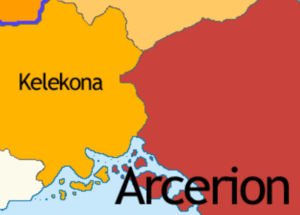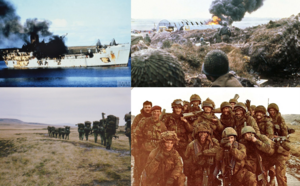Telekonese Conflict
| Telekonese Conflict | |||||||||
|---|---|---|---|---|---|---|---|---|---|
 Arco-Kelekonese Border Region, also known as the Telekonese Lowlands. | |||||||||
| |||||||||
| Belligerents | |||||||||
|
|
| ||||||||
The Telekonese Conflict is an ethnic and territorial conflict between Arcerion and Kelekona over the disputed region of the Innis River Basin and the Dabhóg Wetlands, inhabited by a mixture of different cultural and ethnic groups, but predominantly naturalized Arcers and Kelekonese indigenous peoples. The region is primarily under the control of Kelekona west of the Innis River, but the Telekonese peoples that make up the Southeastern portion of Kelekona are considered a de facto nation and have a diaspora that exists across national boundaries.
The conflicts origins began shortly after the end of the Fourth Bush War and the end of the Kelekonese Civil War, where subversive attempts by Titechaxha and Kelekona to subvert Arcer rule and sovereignty in the Innis River Basin were unsuccessful, as the communist and socialist insurgencies they had sponsored were militarily defeated by the time of the 1975 Gameroun Accords. Repeated calls in the League of Nations and international community by the Kelekonese government to return Telekonese-majority areas of Northwest Arcerion had gone unheeded, and growing frustrations in the Kelekonese government's People's Font's communist leadership meant that their newly acquired sovereignty and power after a devastating civil war was threatened by the existence of Arcer military buildup along the border.
The following series of conflicts were attempts by Kelekona to seize the industrially and economically important Innis River Basin, including the Arcer city of Dunborough, resulting in thousands of military deaths and civilian casualties. This also included the attempts by the Kelekonese government to seize the Foxhey Islands and the disputed areas in the Gibson Gap. Multiple ceasefires and arimstice agreements have subsequently validated Arcer sovereignty, but continued violations have resulted in the ongoing conflict, which has not seen a major outbreak since 2007's escalation. The 2007 conflict resulted in the destabilization of the Yellow Revolution reforms, and the continued slide of Kelekona into sectarian and ethnic infighting amongst rival warlords. This destabilized state has prevented a resurgence in the conflict, although Kelekonan state media consistently blames Arcer involvement, notably the use of the Office of Public Safety and National Security, for the poor state of modern Kelekonese affairs.
Incidents since 2007 are limited, but with Operation REDOUBT and the attempt by Arcerion and the Cape to bilaterally stabilize Kelekona, casualties and attacks against Arcerion have continued to decline.
Background
Arcer settlement and Occidental expansion into the Southeastern Cronan peninsula had forcibly pushed out the Telekonese and Kelekonan Indigenous tribes over two centuries, forcing them to intermix and resettle along Arcerion's Northern and Southeastern border, notably the Innis River Basin and the Washakaran Basin. Kelekona had supported the Fourth Bush War between 1965 to 1974. Notably this manifested in the Operation Kiln and Operation Terrace areas of operation, where the socialist government supported the Free Telokonese People's Movement (FTPM), Telokonan Worker's Army for a Free Crona (TWAFC), and Kelekona supported the Kelekonan Militia for Free Indigenous People (KMFIP). Arming and training these groups covertly had exhausted much of Kelekona's economic and military resources, and after the Gameroun Accords and the armistice, the Kelekonese government sought to again try and liberate and reclaim indigenous Telekonese and Kelekonese peoples settled in the Innis River Basin.
Ethnic conflicts in Northwest Arcerion had long existed between naturalized Arcers, Ardmori migrants, and the Indigenous peoples. Messaging and propaganda by Kelekona had long been aimed at highlighting the supposed oppression of Indigenous minorities, disenfranchisement of native peoples, and the lack of civil rights that the Arcer government afforded to non-white citizens in Norham and Northlea Governorates. Efforts to assist with the creation of non-governmental organizations (NGOs), interfere with local municipal elections, and the creation of support programs for resettlement of Kelekonans to Arcerion had consistently been thwarted by the Office of Public Safety and National Security, as the subversive efforts to undermine the growing Arcosphere were growing amongst the nation's northern border.
By Over the late 1970s and early 1980s, Kelekona had repaired the damage done by the civil war in the country, and focused on improving the instruments of the state, such as its Foreign Affairs and internal security forces. Improvements by the People's Front in government had helped with the establishment with a growing number of militant factions within the government, notably in the General Staff. During this period efforts to expand access to the Gibson Gap and the maritime commercial entrance to Central Crona failed. Dunborough had a monopoly as the main port-of-entry for much of Central Crona, and Kelekonan Ports remained uncompetitive to global markets due to the socialist policies and the traditional proliferation of maritime commerce between Arcerion and major maritime commercial giants such as Burgundie and Kiravia.
In the lead up to the 1986 conflict, Kelekona had been messaging that it had historical claim to the Foxhey Islands and Gibson Gap.
Timeline
| 1986 Conflict | |||||||||
|---|---|---|---|---|---|---|---|---|---|
| Part of Telekonese Conflict | |||||||||
 Photos from the 1986 Conflict (Clockwise from top left): An Arco-flagged merchantman burns at anchor after being hit by Kelekonese fire; Kelekonese soldiers witness the aftermath of an Arco airstrike; Members of 2nd Battalion, Royal Arcerion Regiment pose for a photo in the Gibson Gap; Arcerion Parachute Regiment troopers move overland towards Kelekonese positions. | |||||||||
| |||||||||
| Belligerents | |||||||||
|
|
| ||||||||
| Units involved | |||||||||
|
1 Rifle Brigade 7 Rifle Brigade 11 Parachute Brigade |
22nd Motor Rifle Brigade 71st Motor Rifle Brigade 98th Naval Infantry Brigade 112th Presidential Guard Brigade | ||||||||
| Casualties and losses | |||||||||
|
224 killed 754 wounded 33 captured |
1,032 killed 1,659 wounded ~5,000 captured | ||||||||
1986 Conflict
mini falklands in gibson gap
kelekona push for Dunborough
overall failure
1991 Conflict
attempts to gain oakham and westchester
major armoured battle north of westchester
2007 Conflict
arcer pre-emptive strikes against kelekonese buildup
opsns activities alleged against senior officials
attack over border fizzles out due to relatively weak post revolution government
Fatalities
include a basic table for military casualties on both sides + civilian
Effects on Civilian Infrastructure
destroyed highways
damaged port facilities
railway repairs
Foreign Involvement
Nations
Titechaxha
Malentina
Istrenya
Arms Suppliers
Varshan
Burgundie
As is it's custom, whenever Arcerion goes to war, Burgundie developed a military aid package. During the Telekonese conflicts this occurred in 1986 and 1991, the aid consisted primarily of various fuels and ammunition. In 2007, the package was substantively broader, also including additional land attack cruise missiles.
In all three cases, a small number of Burgoignesc advisor/observers were on hand with front line Arcer troops but conducted no combat operations. Burgundie also took over Arcer naval commitments in the South Songun and Polynesian Seas to allow for the Royal Arcer Naval Service to send additional ships to the Malentine Sea to fight.